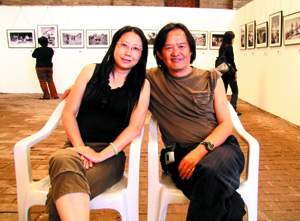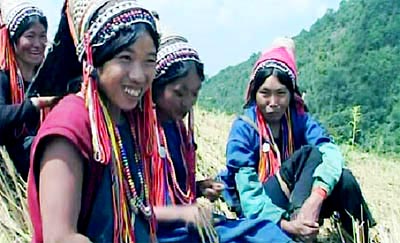For Yang Gancai and his wife Wang Yi, seven years of efforts to chronicle the "disappearing worlds" of Chinese ethnic minorities in a remote village on the country's border with Myanmar have produced more than an award-winning documentary.
The couple is known for their 2006 success with "Transformation", a 140-minute documentary shot over five years. The film depicted the slash-and-burn agricultural methods of the Akha ethnic group who lived in complete isolation in Manbang village of Yunnan Province until a border patrol road was built in 2001. Afterwards radical changes followed as traditional houses were demolished and electricity was installed.
"Transformation" has won several awards at international documentary film festivals in Europe and was among China's top 10 documentaries last year.
Yang, 51, and Wang, 43, have also found in the Akha people a live version of the pre-historical Sanxingdui civilization that has remained a mystery for historians ever since it was discovered in 1986.
According to Yang, legends told in Akha epics could well explain the cultural meaning behind the strange-looking bronze images of humans and birds, and the part-human, part-animal masks with oversized eyes and eyebrows, unearthed from the ruins of Sanxingdui in southwestern Sichuan Province.
"The Akha villagers believe a deity in ancient times had given his own eyeballs to a huge blind bird that had the magic power of annihilating every evil it saw," said Yang. "The villagers therefore worship the bird, or rather its eyes, as their ancestor."
Until today, he said every Akha family has at least one wooden bird nailed on the roof. "Some families have as many as nine."
Yang and his wife said that the heritage items unearthed from two sacrificial pits at the Sanxingdui site seemed to bear the same cultural connotation. "For example, not a single human image had eyeballs. Only the birds did."
Historians have found the Sanxingdui culture, which blossomed from 5000 to 3000 B.C., to be enigmatic and resembles no other pre-historic culture known to modern men.
The "mystery of the masks", strange figures and jade produced by this civilization has even spread as far as UFO and paranormal websites who picked up on a People's Daily article mentioning speculation that aliens might be the answer and quoting locals in the area as having said they spotted UFOs in the area some 20 years ago.
But when Yang and his wife visited the Sanxingdui Museum earlier this year, they found evidence of what a shaman had told them back in the Akha village of Yunnan.
"The shaman told us that people would worship the sacred tree every spring and autumn, and the number of its fallen leaves would represent the number of babies to be born that year."
Among the sacrificial items unearthed from Sanxingdui's pits were several bronze sacred trees.
Some jadeware pieces were inscribed with a boat between two mountains, a token which researchers say was meant to carry the soul of the dead back to their ancestral home.
"Until today, the Akha coffins are in the shape of a boat even though their village is locked in the mountains and I doubt that anyone has ever seen a real boat," said Yang.
The two freelance journalists sold off their private advertisement company in Kunming and tried to settle down in the Akha village of Xishuangbanna in 2001, but were considered "aliens" by the 316 villagers and were denied entry into their community.
The villagers had relocated to Manbang in 1996 to flee bad luck brought on by the inauspicious birth of twins in the tribe.
The Yang couple spent the first nine months in a cabin several kilometers from the primitive village, and tried to follow the villagers whenever they worked in the fields, wove cloth or performed tribal rituals.
Back in 2001 the couple could never take out their camera in public. "When we did, everyone panicked: the men would threaten to fight with us, the women would scream and the children would cry."
In the 10th month, the couple detected signs of a fire, cried out for help and saved the village. They have since won the villagers' trust, been allowed to attend some of their rituals, and have learned their dialect.
With the medicine they brought from Kunming and their limited knowledge of infectious diseases, they saved at least seven villagers who had been declared hopeless cases by the village shaman.
At the end of their fourth year, the couple had shot more than 200 hours of video and 20,000 photos. They witnessed the villagers' first ever use of a light bulb and transcribed nearly every surviving epic in the village.
These epics, handed down orally from generation to generation, are a vivid record of the group's migration, said Yang.
The Akha, whose population is around 500,000 on both sides of the border between Yunnan and Myanmar, is one of more than 20 branches of the Hani nationals in Yunnan. "But their ancestors used to live in nomad tribes in today's Qinghai and Gansu provinces and Tibet."
A noted scholar on Sanxingdui studies has found Yang's Akha interpretation of the Sanxingdui "exciting".
"The seashells unearthed from the site were found only in the deep water of the Indian Ocean, but were later found at several other heritage sites in Yunnan and Sichuan," said Prof. Duan Yu with Sichuan Normal University. "All these sites are along an ancient trade route to Myanmar and southeast Asia, with the Sanxingdui at the starting point."
"If Yang's hypothesis proves true, we can probably assume the Sanxingdui civilization used to dominate southwestern China and even South and Southeast Asia," said Duan.
It would mean the forefathers of today's Akha people had trekked far to spread the civilization to where it is today, said Prof. Yang Hui, an anthropologist with Yunnan University.
"In 1938, an American scholar spent more than 20 days traveling in caravan from the China-Myanmar border in Xishuangbanna to Yunnan's provincial capital Kunming alone," said the professor.
With modern highways and a superb cross-country vehicle, Yang and his wife need only 15 hours.
Yang has brought a full set of miniatures of the Sanxingdui ruins, which he plans to show the Akha villagers in two weeks. "Hopefully we'll find out more mysteries about the Sanxingdui culture."
(Xinhua News Agency December 14, 2007)





